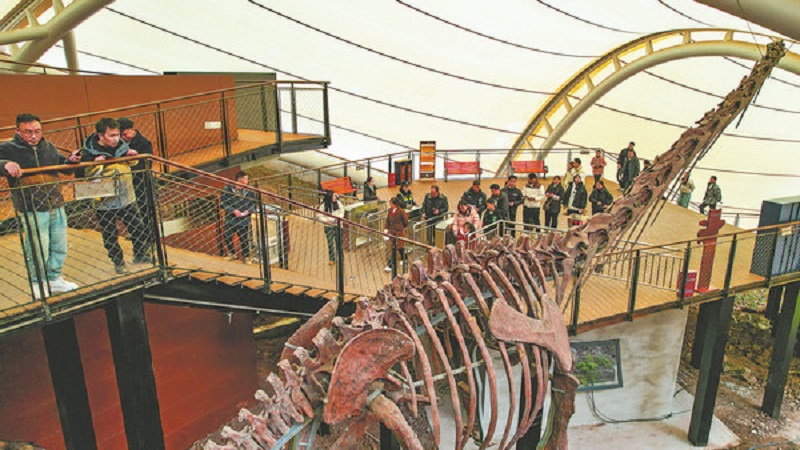China's new geopark wins global recognition as it makes UN list

Where dinosaurs once roamed and ancient landscapes whisper stories from hundreds of millions of years ago, the Yunyang Geopark in southwestern China is a monument to the prehistoric past.
Its most famous feature — the Great Wall of Dinosaur Fossils — is an 18 km stretch of rock layers packed with fossils dating back nearly 170 million years that draws visitors into a world shaped by time, tectonics, and towering creatures.
Now, this remarkable park has earned international recognition. On April 17, the United Nations Educational, Scientific and Cultural Organization officially announced that Yunyang has been added to the UNESCO Global Geoparks Network — a major milestone in China's ongoing efforts to preserve its geological heritage and promote geotourism.
Yunyang joins the list alongside the Kanbula Geopark, located on the northeastern edge of the Qinghai-Tibet Plateau. The two are among 16 new sites recognized this year. With their addition, China's total number of UNESCO Global Geoparks stands at 49, maintaining the country's position as the global leader in geopark designations.
Established in 2015, the UNESCO Global Geoparks Network highlights sites of international geological significance that tell the story of Earth's history, evolution, and climate. With 16 new additions this year, the network now includes 229 geoparks around the globe.
"In 10 years, UNESCO Geoparks have become models for the conservation of geological heritage. But their role goes much further: they support educational projects, promote sustainable tourism and keep the knowledge and traditions of these territories alive through the active participation of local and indigenous communities," says UNESCO Director-General Audrey Azoulay.
Officially designated the Yunyang UNESCO Global Geopark, the site is within the Three Gorges Reservoir area in Yunyang county, Chongqing. Covering some 1,100 square kilometers, the geopark blends science education, folk culture, tourism, and ecology in a single destination.
It is home to landscapes formed nearly 250 million years ago, which capture the dramatic retreat of an ancient inland sea and the rise of a distinctive land-based ecosystem in its wake.
The region is renowned for its fossil deposits, and one exceptional area has revealed around 5,000 fossils, which have provided invaluable insight into dinosaur evolution during the Middle Jurassic period.
The geopark is also home to stunning karst landscapes, limestone rock formations eroded by water over time. Among the natural wonders is one of the world's deepest sinkholes, which plunges 335 meters and is an important site for geological research.
Home to the Tujia ethnic group, Yunyang Geopark helps preserve local traditions like root carving and brocade weaving. It supports handicraft production, promotes cultural education in schools, and hosts events such as the Tujia Daughters' Meeting, encouraging community participation and passing down heritage to younger generations.
"This is a valuable opportunity for Yunyang to step beyond Chongqing and reach national and international audiences," says Chen Daobin, Party Secretary of Yunyang county. "It will also enable us to participate more actively in global exchange, promote local agricultural and industrial products on a larger stage, attract new investment, and create more jobs."
Yunyang is accelerating efforts to create an international tourism and resort destination, with the number of annual visitors projected to exceed 1.5 million by 2027.
"We aim to boost Yunyang's profile through the geopark, stimulate the local economy through consumer activity, drive popularity through events, highlight regional culture through food, and integrate urban and rural resources to showcase local charm," Chen says.
"Our goal is to develop the cultural tourism sector under an all-area, all-season, all-day, all-element, and all-industry model, to ensure local communities benefit from environmental preservation and tourism-driven development."
Xiong Yijun, an official with the Chongqing planning and natural resources bureau, highlighted the park's paleontological significance.
"The Middle Jurassic dinosaur fossil cluster in Yunyang fills a crucial evolutionary gap between the Lufengosaurus and Shunosaurus faunas, linking a key stage in Jurassic dinosaur evolution in Asia," Xiong says. "It's a major discovery of global relevance."
Looking ahead, Chongqing will continue to tap into its fossil heritage. "We plan to build a comprehensive conservation network that connects individual sites into a larger framework," Xiong adds.
"By integrating paleontology with cultural tourism, we plan to turn fossil resources into a new driver of regional economic growth."
(Source from China Daily)